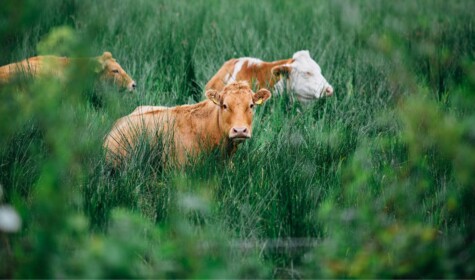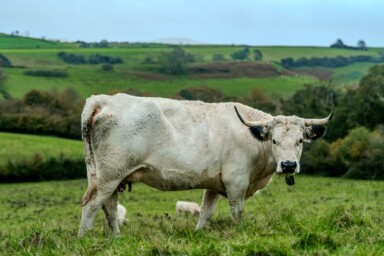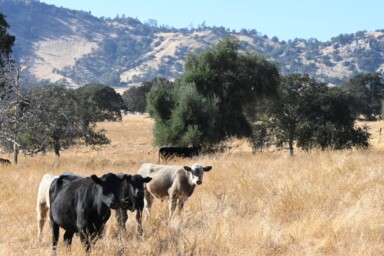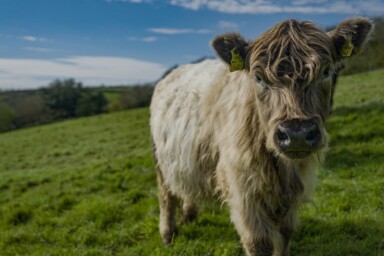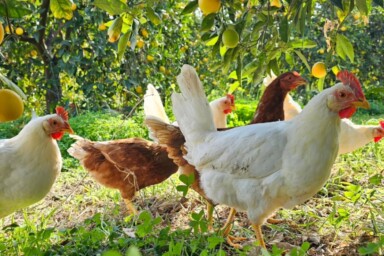On 16 August, The Guardian published ‘The most damaging farm products? Organic, pasture-fed beef and lamb’, an article by George Monbiot. The piece consists of points from Monbiot’s recent book, Regenesis: Feeding the world without devouring the planet, which the SFT has already reviewed. We respond to four of the claims that require specific interrogation.
Monbiot’s basic argument is that organic and pasture-fed livestock take up more land than any other type of farming and are therefore the least efficient and most environmentally destructive form of food production. We fundamentally disagree with this. In reality, well-managed organic and pasture-fed livestock:
· convert grass and other feeds humans can’t eat into nutrient-dense food, which is a highly efficient use of resources;
· are essential for the survival of many of the UK’s most important habitats and species;
· have an important role to play in the transition to climate- and nature-friendly food and farming systems which don’t rely on energy-intensive, non-renewable inputs.
None of this detracts from the urgent need to reduce the amount of meat we eat, (something which Henry Dimbleby, leader of the Government’s National Food Strategy, is quoted as calling for in a separate article published by The Guardian). However, where we differ from both Monbiot and Dimbleby is that we believe that this should be delivered through major reductions in grain-fed meat production, which would affect chicken and pork more significantly than beef and lamb.
The fundamental reason for this is that over half of the world’s grasslands are unsuitable for crop production, while including grass in arable crop rotations on the most degraded soils is the best way to restore soil carbon and resilience. Grain and other arable crops can be consumed directly by people; grass can only contribute to human nutrition if it is first converted to milk or meat by grazing animals.
Below, we give our response to four of the key claims made by Monbiot.
-
Claim: Grazing livestock are inefficient at producing food
Response: Grazing livestock are able to convert grass and other feeds humans can’t eat into nutrient-dense meat and dairy, which represents an efficient use of resources
At the heart of Monbiot’s opposition to grazing livestock is their perceived inefficiency. He supports this with an argument he has made many times before: that 28% of the planet’s land surface is used for grazing, but that animals reared entirely on grass produce just 1% of the world’s protein. This is grossly misleading. While entirely grass-fed ruminants only make up a small percentage of the global herd/flock, most of these animals belong to subsistence farmers in dryland regions where grass quality is very poor and crops are frequently devastated by prolonged droughts. However, all sheep and cattle receive a substantial part of their diet from grass. While no exact global figures are available, in the UK, grass contributes over 20 grams of high quality protein per person per day through meat and milk, one third of the recommended intake. In Regenesis, Monbiot also states that, “cattle, goats and sheep are less efficient converters of protein than chickens and pigs.” This is also misleading. Chickens and pigs are only more efficient at converting grain to meat. Cattle, goats and sheep are far more efficient at converting grass into meat (and milk) than chickens and pigs, making ruminants of greater value at converting human inedible protein into human edible protein.
Monbiot also overlooks that fact that almost two-thirds of global grassland is unsuitable for arable cropping. Meat and milk produced from most grasslands and other human-inedible feeds, e.g. crop by-products and food waste, therefore represent an additional and complementary source of nutrition to that provided by crops, since these resources would otherwise provide no contribution to the human food supply. One review, which explained why overall consumption of animal foods needs to decline, found that livestock reared solely on grass and other inedible feeds could provide 20-50% of the world’s protein, 10% of our energy and iron, 20% of our calcium and zinc and 75% of our vitamin B12 needs. Significantly, this approach would require 25% less arable land than under a vegan scenario.
-
Claim: Grazing livestock are bad for biodiversity
Response: Well-managed grazing livestock are hugely important for many habitats and species in the UK
Monbiot also claims that in almost all instances, grazing livestock are bad for nature, citing a global review of studies which found that having no grazing is better for almost every category of wild animal. He ignores the fact that the same study highlighted instances where grazing is good for biodiversity. In addition, a more recent paper by the same authors acknowledges that by only comparing grazed versus ungrazed areas, their review didn’t account for grazing intensity, which they acknowledge is essential for an accurate assessment of impacts on biodiversity.
In reality, as most ecologists would recognise, the effect of grazing on biodiversity is hugely context dependent. Some habitats and species benefit from having zero or very low levels of livestock grazing (as Monbiot references), while others benefit from or even rely upon the extensive grazing he constantly rails against. This is particularly the case in countries like the UK where many species and habitats have co-evolved with grazing animals throughout a long history of farming.
It is true that many of the world’s grasslands would benefit from less intensive and more sympathetic grazing practices. In the UK, intensive management in the lowlands (especially on the most intensive dairy farms with very high nitrogen fertiliser use) and overgrazing and the move to sheep-only systems in many parts of the uplands, has had negative impacts on biodiversity. However, undergrazing is now also a growing concern in some areas. We undoubtedly need many more trees in the landscape, but there are ways this could be achieved without the wholesale conversion of large areas of grassland to commercial timber plantations at the expense of the many important species which rely on open-ground habitats. We also need to make sure that tree planting is undertaken in a way that benefits the whole country and doesn’t just become another form of greenwashing for polluting industries. Currently, investors are buying up grassland for afforestation so they can sell carbon credits to industries that want to continue using fossil fuels, rather than investing in renewables.
-
Claim: Grass-fed livestock are worse than intensive livestock for climate change
Response: A nationwide transition to agroecology, which grazing livestock are key to achieving, could significantly reduce the UK’s agricultural emissions
Monbiot’s claim that organic and grass-fed beef and lamb are worse for the climate than intensive products has been made many times before, but this is a massive simplification. What is probably the most detailed comparison of the carbon footprint of organic and conventional beef in the UK, found that the on-farm footprint of conventional beef was 15.028 kg of CO2-equivalent per kilo of beef, whereas that for organic beef was lower at 13.46 kg. The impact on global warming, however, is much lower than even these figures indicate, because all current calculations still measure the climate impact of methane in an inaccurate way, which fails to account for its short life in the atmosphere compared with the indefinite life of all additional CO2 emissions.
Monbiot also criticises grazing livestock for preventing woodland expansion and the associated carbon storage – what is generally called a ‘carbon opportunity cost’. But this ignores the major potential for organic and pasture-fed grazing livestock farms to sequester carbon by restoring degraded soils through good grazing management, including where grass is incorporated into arable crop rotations, and through the greater integration of trees and hedgerows into pasture. As the technical data behind CPRE’s Hedge Fund report makes clear, each square kilometre of grassland in the UK already contains 57% more hedgerow than each square kilometre of cropland, (5.25 km compared with 3.34 km). It also supposes that the conversion of the UK’s grass and moorlands to woodland is invariably a good thing for carbon, but this is not always the case: there is good evidence that tree planting on many upland soils, already high in organic matter may not result in a net carbon gain.
It is also vital that we assess the climate impact of cattle and sheep from a whole food system perspective, rather than purely on the basis of individual product footprints. Doing so shows that a nationwide transition to agroecology, which grazing livestock are key to achieving, could lead to a 55-70% fall in the UK’s agricultural emissions – providing we simultaneously transitioned to more sustainable diets.
-
Claim: Sustainable production couldn’t feed Britain
Response: Sustainable, nature-friendly farming could feed the UK, provided we change our diets and waste less food
Ultimately, the main argument Monbiot levels against grazing livestock and nature-friendly farming systems more broadly, is that they do not produce enough food per hectare of land. This results in the bizarre situation where, despite advocating veganism in Regenesis, he ends up arguing that US feedlot beef, produced on grain and soya, is the better approach to beef production because it produces more beef per hectare.
However, while yields are obviously an important consideration (and increasing these in agroecological systems will be possible, given adequate research and development), it is not necessarily the case that a nature-friendly approach to food production would require more farmland. In fact, dietary change, especially an overall reduction in grain-fed meat consumption, along with a reduction in the amount of land used to grow bioenergy crops, could make space for lower-yielding but more environmentally-friendly farming systems, while still freeing up land for rewilding or other purposes – as has been shown recently at both an EU and UK level.
In relation to both Monbiot’s and Dimbleby’s positions, it is important to point out the dangers of continuing to rely on intensive agriculture, as the National Food Strategy recommends for the country’s best land. This summer has shown the threat a changing climate poses to food production, with yields well down due to drought. While agroecological systems are not immune to climate change, they have the potential to be more resilient in the face of extreme weather, due to higher levels of soil organic matter, greater diversity of crops and the efficient integration of crops and livestock at an on-farm level. Food systems that continue to rely heavily on agrochemicals (as would be necessary under both Monbiot’s and Dimbleby’s approaches) also carries risks, as we have seen recently, with the three-fold increase in the cost of nitrogen fertiliser, higher energy prices and the accumulating evidence over the safety of glyphosate, the world’s most widely used pesticide.
Conclusion – Where the SFT, George Monbiot and Henry Dimbleby all agree
If the global population continues to grow, as predicted, and if developing countries continue to move in the direction of Western, high meat diets, we will face a global ecological and climate disaster because it will be impossible to increase meat consumption sufficiently without destroying even more wild land for agriculture, including further vast tracts of the Amazon rainforest. As such, we strongly agree with both Monbiot and Dimbleby, that meat consumption will have to decline in the UK and in other developed countries. This is not, however, an argument for slashing the production of beef and lamb in a country like the UK, where crop production is impossible or problematic on more than half the farmland area – it is exactly the opposite. Beef produced on former rainforest land has a carbon footprint of approximately 700 kg of CO2 per kg of meat, largely due to the carbon and other greenhouse gases released when trees are burned, and because tropical soils quickly degrade once converted to food production. That results in a carbon footprint more than 40 times higher than beef produced in the UK.
But, while Monbiot, Dimbleby and others assume it is grass-fed meat production that needs to decline, due to its lower protein productivity per hectare than chicken and pigs fed on grain, we see it as fundamentally more important to reduce our consumption of grain-fed meat, in large part because continuous crop production degrades soils. As research by British scientists finds, 38% of our cropland soils in the UK are already degraded, compared with less than 7% of grassland soils. High grain production also depends on a wide range of unsustainable inputs, produced from non-renewable resources at a high carbon cost. Intensive grain-fed systems also cause huge amounts of air and water pollution and confine animals in unnatural and stressful conditions. In contrast, well-managed grazing animals can play a valuable role in a climate-friendly food system, providing a range of key social and environmental benefits, including a significant and resource-efficient contribution to the food supply, a vital source of income for rural communities, benefits for biodiversity and an important role in reducing agrochemical inputs by building fertility and reducing weeds, pests and diseases in cropping systems, through rotations that include grass and forage legumes, like clover.
